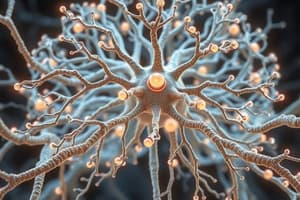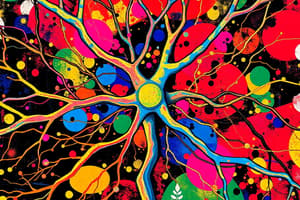Podcast
Questions and Answers
What are the two main parts of the nervous system?
What are the two main parts of the nervous system?
- Somatic nervous system and endocrine system
- Central nervous system and peripheral nervous system (correct)
- Sympathetic nervous system and peripheral nervous system
- Autonomic nervous system and central nervous system
What is the main function of the axon in a neuron?
What is the main function of the axon in a neuron?
- Transmits electrical impulses away from the cell body (correct)
- Processes input signals from other neurons
- Conducts sensory information to the cell body
- Serves as a metabolic center for nerve cells
Where are nerve cell bodies located in the nervous system?
Where are nerve cell bodies located in the nervous system?
- Exclusively in the spinal cord
- Only in the peripheral nervous system
- In the cerebral cortex only
- In nuclei inside the central nervous system and ganglia outside (correct)
What does depolarization involve in the conduction process?
What does depolarization involve in the conduction process?
Which of the following structures are involved in the input and output system of the nervous system?
Which of the following structures are involved in the input and output system of the nervous system?
What role do glia cells play in the nervous system?
What role do glia cells play in the nervous system?
How does the myelin sheath affect signal conduction?
How does the myelin sheath affect signal conduction?
What occurs at synapses?
What occurs at synapses?
What happens when neurotransmitters bind to post synaptic receptors?
What happens when neurotransmitters bind to post synaptic receptors?
Which of the following accurately describes how neurotransmitters are removed from synapses?
Which of the following accurately describes how neurotransmitters are removed from synapses?
What effect do drugs like SSRIs have on neurotransmitter levels?
What effect do drugs like SSRIs have on neurotransmitter levels?
What happens to a single presynaptic pulse that is too weak?
What happens to a single presynaptic pulse that is too weak?
Which of the following is NOT a common way that drugs affect neurotransmission?
Which of the following is NOT a common way that drugs affect neurotransmission?
Flashcards
Central Nervous System
Central Nervous System
The brain and spinal cord, acting as the central processing unit (CPU) of the body.
Peripheral Nervous System
Peripheral Nervous System
Includes spinal nerves and branches, as well as the nervous mesh in internal organs. It acts as the input/output system of the body.
Neuron
Neuron
The functional unit of the nervous system, responsible for transmitting information.
Axon
Axon
Signup and view all the flashcards
Dendrites
Dendrites
Signup and view all the flashcards
Schwann Cells
Schwann Cells
Signup and view all the flashcards
Oligodendrocytes
Oligodendrocytes
Signup and view all the flashcards
Myelin Sheath
Myelin Sheath
Signup and view all the flashcards
Saltatory Conduction
Saltatory Conduction
Signup and view all the flashcards
Multiple Sclerosis (MS)
Multiple Sclerosis (MS)
Signup and view all the flashcards
Synapse
Synapse
Signup and view all the flashcards
Neurotransmitters
Neurotransmitters
Signup and view all the flashcards
Neurotransmitter Removal
Neurotransmitter Removal
Signup and view all the flashcards
Study Notes
The Nervous System
- The nervous system has two main parts:
- Central Nervous System (CNS): Composed of the brain and spinal cord, acting as the central processing unit (CPU)
- Peripheral Nervous System (PNS): Consists of spinal nerves, their branches, and a network in internal organs. It acts as the input and output system for the CNS. The PNS carries signals between the CNS and other parts of the body.
Functional Units: Neurons
- The basic building block of the nervous system is the neuron.
- The human body contains over 100 billion neurons.
- Each neuron is comprised of a cell body, various branches (dendrites), and a main branch called the axon.
- The axon is the functional unit for transmitting signals.
Neuron Structure and Function
- Cell body: Responsible for metabolic processes within the neuron.
- Axon: The main conductor of impulses, transmitting signals away from the cell body.
- Dendrites: The input zone of the neuron, receiving signals from other neurons.
Nerve Cell Bodies
- Nuclei: Clusters of nerve cell bodies located inside the central nervous system (CNS).
- Ganglia: Clusters of nerve cell bodies situated outside the CNS.
Main Function: Conduction
- Neurons transmit information through electrical signals called action potentials.
- Information flows through neurons with dendrites collecting incoming electrical signals, the cell body integrating these signals, and the axon generating an outgoing signal to another neuron or effector cell.
Action Potential Transmission Methodology
- Specific gates in the axon membrane allow positively charged ions to pass, changing the membrane charges inside and outside the axon.
- There is a fast inward flow of sodium ions, which results in depolarization.
- Repolarization is a fast outward flow of potassium ions.
Glial Cells (Support Cells)
- Glia cells are support cells that surround and assist neurons.
- They provide structural and metabolic support, and insulation for neurons.
- In peripheral nerves, Schwann cells provide myelination.
- In the CNS, oligodendrocytes provide myelination.
Myelin Sheath
- Made by glia cells
- Acts as insulation (a fatty sheath)
- Allows faster transmission of action potentials by saltatory conduction, jumping from node to node.
Multiple Sclerosis (MS)
- A disease that damages the myelin sheath.
- Loss of myelin disrupts nerve signal transmission, causing various symptoms.
- MS has different classifications (ranging from benign to progressive forms)
Synapses
- Synapses are the junctions between neurons and/or neurons to muscle or glands.
- The synaptic gap is too wide for the action potential to cross, hence signal transmission occurs via chemicals called neurotransmitters.
- Neurotransmitters are released from the presynaptic neuron, cross the gap and bind with receptors in the postsynaptic neuron, triggering an action potential.
Transmitter Removal from Synapse
- Neurotransmitters are removed from the synapse by:
- Enzymatic degradation
- Reuptake into the presynaptic cell
Drugs
- External drugs can affect the nervous system by mimicking, increasing or blocking neurotransmitters.
- Drugs can alter neurotransmission by binding to receptors, affecting the release or degradation of neurotransmitters.
Studying That Suits You
Use AI to generate personalized quizzes and flashcards to suit your learning preferences.



